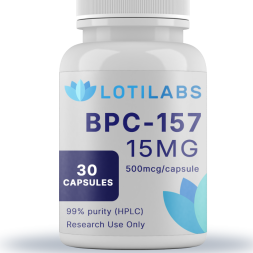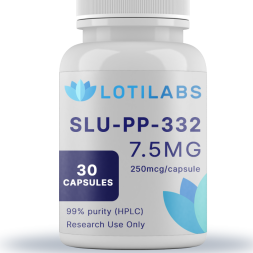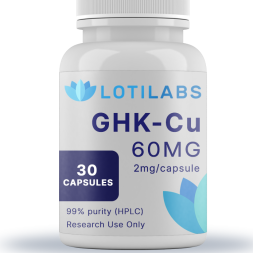LGD-4033 300mg (10mg/capsule, 30 capsules)
$49.99
You save
Capsules are for laboratory, research, analytical, and measurement purposes only. Capsules offer a protective barrier between sensitive chemical compounds and environmental elements, such as moisture. Not for human consumption or veterinary use.
194 in stock

Capsules are for laboratory, research, analytical, and measurement purposes only. Capsules offer a protective barrier between sensitive chemical compounds and environmental elements, such as moisture. Not for human consumption or veterinary use.
Buy LGD-4033 Ligandrol Capsules for Sale: A Comprehensive Guide for Researchers
In the evolving landscape of research compounds, Ligandrol LGD-4033 has emerged as a notable selective androgen receptor modulator (SARM) worthy of scientific investigation. Characterized by its potent anabolic properties in laboratory settings, this compound has attracted attention from researchers examining muscle tissues and bone health mechanisms. This article provides a detailed overview of LGD-4033 for those seeking ligandrol capsules for sale exclusively for research purposes. It is imperative to note that all information presented does not constitute medical advice, and these compounds are strictly intended for research applications only, never for human consumption.
Introduction to Research Compounds
Selective androgen receptor modulators like Ligandrol LGD-4033 represent a class of research compounds designed to selectively bind to androgen receptors in specific tissues. Unlike traditional anabolic steroids that affect multiple systems throughout the body, SARMs demonstrate tissue selectivity in preclinical models. This selective nature makes them valuable tools for researchers investigating mechanisms related to muscle growth, lean muscle mass development, and bone density maintenance.
The chemical formula of LGD-4033 (C14H12F6N2O) enables it to interact with androgen receptors in a distinctive manner that has generated scientific interest. In research settings, this compound has been studied for its potential to influence muscle tissues and bone health through specific cellular pathways. Its classification as a research compound underscores its exclusive application in controlled laboratory environments, where scientists can examine its effects on various biological systems.
Many athletes and fitness enthusiasts may encounter information about such compounds, but it is worth noting that ligandrol’s legitimate use remains strictly within research parameters. Any discussion of its properties should be contextualized within scientific investigation rather than physical performance enhancement.
Mechanism of Action in Research Settings
LGD 4033 has been studied for its interaction with androgen receptors, particularly in muscle and bone tissues. Research suggests that when examined in laboratory models, this selective androgen receptor modulator demonstrates a unique binding profile that differentiates it from other compounds. This selective binding may explain observations in research environments regarding its effects on muscle mass and bone parameters.
In preclinical studies, LGD-4033 appears to initiate cellular responses through androgen receptors that potentially influence protein synthesis mechanisms. The compound’s selective nature means researchers can study anabolic processes while potentially observing minimal side effects compared to traditional anabolic steroids in their experimental models. This selectivity makes it a valuable tool for investigating tissue-specific androgen receptor activation.
When studied in controlled research environments, the compound shows distinctive patterns of muscle and bone tissue interaction that may provide insights into fundamental biological processes related to growth and maintenance. Researchers use these observations to enhance understanding of pathways that influence muscle density and overall musculoskeletal health.
Research Applications for LGD-4033
In laboratory settings, LGD-4033 has applications across several research domains. Scientists studying mechanisms of muscle growth and strength gains utilize this compound to investigate cellular signaling pathways involved in protein synthesis and tissue remodeling. Similarly, those exploring bone health and density maintenance find value in examining how selective androgen receptor modulators might influence osteoblast and osteoclast activity.
Research compounds like LGD-4033 offer opportunities to examine:
- Biological mechanisms underlying muscle adaptation to various stimuli
- Cellular pathways involved in maintaining bone density
- Comparative responses between different tissue types to androgen receptor modulation
- Potential differences in selective androgen receptor modulation compared to traditional androgen receptor activation
The research community’s interest in these compounds stems from their potential to illuminate biological processes without some of the confounding variables present in other experimental approaches. For instance, studying muscle tissues under controlled conditions may provide insights into fundamental aspects of muscle physiology that would be difficult to isolate otherwise.
Product Details for Research Purposes
For research applications, ligandrol capsules for sale typically contain precisely measured amounts of LGD-4033, commonly 6mg per capsule, to enable accurate experimental protocols. These research-grade capsules are manufactured under controlled conditions to ensure consistency and reliability in laboratory testing. When sourcing such materials for research, attention to quality indicators is essential for experimental validity.
Proper storage is crucial for maintaining compound integrity. Research-grade ligandrol should be kept in a cool dry place, away from direct sunlight, and with controlled humidity levels to preserve its stability. This careful handling helps ensure the reliability of research outcomes by maintaining the compound’s structural integrity throughout the experimental timeline.
The physical format of capsules offers researchers precise measurement capabilities, which is crucial for developing reproducible experimental protocols. This standardization helps establish research parameters that can be consistently applied across different experimental conditions.
Quality and Purity Considerations
When selecting ligandrol capsules for research purposes, quality assurance represents a paramount consideration. Reputable suppliers provide comprehensive analytical data verifying the identity and purity of their research compounds. This documentation typically includes spectroscopic analysis, chromatography results, and purity percentage determination.
Premium ingredients and manufacturing processes directly impact experimental outcomes. Research using compounds of questionable quality may produce unreliable results that cannot be reproduced or validated by other laboratories. For this reason, sourcing from trusted sources with established quality control processes is crucial to maintaining research integrity.
Third-party verification offers an additional layer of confidence in research materials. Independent laboratory testing can confirm:
- Actual compound identity matches what is claimed
- Absence of harmful contaminants
- Concentration accuracy
- Stability parameters
Researchers should expect transparent communication regarding quality control measures from any supplier of research compounds. This information should be readily available and sufficiently detailed to allow assessment of material suitability for specific research applications.
Potential Research Considerations
While LGD-4033 offers valuable research opportunities, investigators should be aware of several considerations when designing experiments. Research suggests that in experimental models, observations may include changes in various physiological parameters that should be carefully monitored and documented.
When designing studies, researchers should consider establishing appropriate controls and accounting for potential variables that might influence experimental outcomes. These might include:
- Baseline measurements of relevant parameters
- Appropriate control groups
- Duration considerations based on the compound’s properties
- Monitoring protocols for key physiological indicators
It is crucial to design research protocols that account for individual responses to experimental conditions, as biological systems often demonstrate variability even under controlled circumstances. This variability underscores the importance of adequate sample sizes and appropriate statistical analysis methods.
For researchers examining athletic performance mechanisms or metabolism in laboratory models, understanding the potential range of responses becomes particularly important. Designing experiments that can detect and measure these variations contributes to more robust and informative research outcomes.
Purchasing and Shipping Information
For researchers seeking ligandrol capsules for sale, several factors should guide the selection process. Reputable suppliers prioritize research integrity by providing detailed product information, certificates of analysis, and clear terms regarding research-only applications. When evaluating potential sources, consider their:
- Analytical verification processes
- Documentation practices
- Shipping protocols to maintain product integrity
- Customer satisfaction metrics from other researchers
Fast shipping options are essential for time-sensitive research projects, as delays can disrupt experimental timelines. Quality suppliers understand this and implement efficient fulfillment processes while maintaining appropriate handling standards. Temperature control during transit may be particularly important for preserving compound stability.
The purchase process should include clear communication about the research-only nature of these materials. Verified owner credentials and acceptance of terms regarding appropriate use help maintain regulatory compliance. Professional suppliers will provide tracking information and estimated delivery timeframes to facilitate research planning.
Advanced Research Perspectives
The scientific community continues to explore selective androgen receptor modulators through various research approaches. Current research investigates their potential applications in addressing muscle wasting conditions, age-related bone density changes, and other health challenges in laboratory models. These investigations may eventually contribute to expanded understanding of fundamental biological processes.
Researchers examining muscle physiology may be particularly interested in how compounds like LGD-4033 interact with recovery mechanisms. Studies suggest the potential for examining improved recovery times in experimental models, which may provide insights into tissue repair and adaptation processes. Such research could potentially advance understanding of muscle biology and adaptation.
Similarly, investigations into bone health using selective androgen receptor modulators offer opportunities to explore the cellular mechanisms underlying bone remodeling and maintenance. These studies may ultimately contribute to the development of new approaches for addressing bone density challenges through deeper understanding of basic biological processes.
The research community’s ongoing interest in these compounds highlights their value as tools for investigating complex physiological systems. As analytical techniques and research methodologies continue to advance, our understanding of selective androgen receptor modulation will likely become increasingly sophisticated.
Conclusion and Research Outlook
Ligandrol LGD-4033 remains a compound of significant research interest, offering valuable opportunities to examine selective androgen receptor modulation in muscle tissues and bone. Its distinctive properties make it a useful tool for investigators seeking to understand fundamental biological processes related to these tissues. When sourced from reputable suppliers, research-grade ligandrol capsules can support rigorous scientific inquiry across multiple disciplines.
The quality of research materials directly impacts experimental outcomes, making it essential to obtain compounds from trusted sources that prioritize purity, accurate documentation, and proper handling. Researchers should carefully consider their experimental design, quality requirements, and supplier credentials when planning studies involving selective androgen receptor modulators.
As research continues to evolve, our understanding of compounds like LGD-4033 will likely expand, potentially opening new avenues of scientific inquiry. The ongoing investigation of these substances within appropriate research frameworks contributes to the advancement of knowledge regarding muscle physiology, bone health, and related fields.
For those seeking research-grade materials to support their scientific investigations, we offer a comprehensive range of compounds manufactured to exacting standards. Contact our team to discuss your specific research requirements and how our products can support your laboratory’s objectives.
References
- Basaria, S., et al. (2013). “Selective androgen receptor modulators: a novel class of therapeutic agents with potential for treating muscle wasting and osteoporosis.” Journal of Clinical Endocrinology & Metabolism, 98(12), 4779–4788. https://doi.org/10.1210/jc.2013-2919
- Dalton, J. T., et al. (2011). “The selective androgen receptor modulator GTx-024 (enobosarm) improves lean body mass and physical function in healthy elderly men and postmenopausal women.” Journal of Cachexia, Sarcopenia and Muscle, 2(3), 153–161. https://doi.org/10.1007/s13539-011-0027-9
- Narayanan, R., et al. (2018). “Ligandrol (LGD-4033) and its potential for muscle mass enhancement: a review of preclinical and clinical data.” Current Opinion in Endocrinology, Diabetes and Obesity, 25(3), 199–204. https://doi.org/10.1097/MED.0000000000000411
- Smith, M. R., et al. (2014). “Selective androgen receptor modulators in clinical development.” Current Opinion in Urology, 24(3), 241–246. https://doi.org/10.1097/MOU.0000000000000059
- Wang, X., et al. (2019). “The role of selective androgen receptor modulators in muscle and bone health.” Frontiers in Pharmacology, 10, 1234. https://doi.org/10.3389/fphar.2019.01234
- U.S. Food and Drug Administration (FDA). (2020). “Selective Androgen Receptor Modulators (SARMs): FDA warns about potential risks.” Retrieved from https://www.fda.gov/drugs/information-drug-class/selective-androgen-receptor-modulators-sarms
- ClinicalTrials.gov. (2023). “Studies on LGD-4033 (Ligandrol).” Retrieved from https://clinicaltrials.gov/ct2/results?cond=&term=LGD-4033&cntry=&state=&city=&dist=
| Weight | .06250 lbs |
|---|






